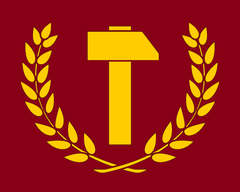Workers' Party (Yonderre): Difference between revisions
(Created page with "{{Infobox political party | name = Workers' Party | native_name = Parti Travailleuer (Burgoignesc)<br>Partei der Arbeiter (East Gothic language|Goth...") Tag: 2017 source edit |
mNo edit summary Tag: 2017 source edit |
||
| Line 1: | Line 1: | ||
{{Short description|Yonderian communist party}} | |||
{{WIP}} | |||
{{Infobox political party | {{Infobox political party | ||
| name = Workers' Party | | name = Workers' Party | ||
Revision as of 09:27, 15 March 2021
Script error: The module returned a nil value. It is supposed to return an export table.
This article is a work-in-progress because it is incomplete and pending further input from an author. Note: The contents of this article are not considered canonical and may be inaccurate. Please comment on this article's talk page to share your input, comments and questions. |
 | |
| Leader | Reikhart Müller |
| Founded | 14 August 1918 |
| Headquarters | Toubourg |
| Newspaper | Le Travailleuer (The Worker) |
| Membership | 1919: 2,000 1928: 50,0000 1948: 125,000 1960: 150,000 1980: 130,0000 2020: 65,000 |
| Ideology | Communism Marxism-Leninism |
| Political position | Far-left |
| National affiliation | Red Bloc |
| Colours | Deep Red |
| Slogan | Workers unite! |
| Yonderian Parliament | 15 / 179 |
The Workers' Party, known as Parti Travailleuer in Burgoignesc and Partei der Arbeiter in Gothic is a communist political party in Yonderre. The party was founded in 1918 by members from the Social Democrats, breaking away to pursue a more hardline form of socialism. Formed chiefly by workers in Toubourg, the party grew steadily in popularity, being first represented in Yonderian Parliament in 1928. The party grew in strength throughout the Great War years until peaking in the 1960s. Unpopular leadership led to a steady decline in popularity through the 1970s and 80s until a faction broke off and formed the Red-Greens in 1985, taking with them more than a third of the WP's members.
Although its electoral support has declined in recent decades, the WP retains an influence in Yonderian politics, especially at the local level.
Press
Since its first printing on November 1st, 1918, the Workers' Party publishes Le Travailleuer (The Worker), initially twice per month and at its height in the 1960s three times a week.